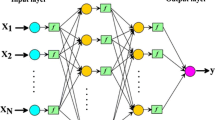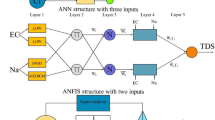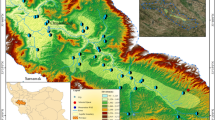Abstract
Salinization of streams, rivers and other water sources threaten the civilizations, ecologies enduring constituent species that results in rendering the precious water unusable for human chores. Increase in salinity across the flow in streams and wet-lands have been mostly to raise a concern towards salt tolerance to various limits. Hence, it becomes important to monitor the acidity/alkalinity causing water parameters that can be referred to as salinity. The prime measure scale of salinity is the quality of potential-of-hydrogen (pH) present in river waters at two sample locations. Two locations that have been identified by CPCB as per the highly reported pollutants’ level found, have been analysed through artificial-intelligence (AI) conjucted with Multivariate Adaptive Regression Spline (MARS). The hybrid of wavelet neuro-fuzzy inferences with that of MARS (WNF-MARS) predicted with more accuracy. Simulation of performance measures: root meant square error (RMSE); mean absolute error (MAE); goodness-of-fit (R2) together with their execution time for the three prototypes provided remarkable results. RMSE outcomes diminish on the whole on applying the training and validating data division in Wavelet conjucted MARS and WNF-MARS as compared to studying the data through MARS. Goodness-of-fit statistic analysed the concentration levels of salinity in the river at the identified sites. Thus, it is observed from this study that the pH levels provide future estimation of inapt quality of water at the source, so that it prohibits the further-decay of water consumed in the ecosystem. Thus, these predictors would be helpful towards formulation of strategies for protection of vegetation and other required purposes.














Similar content being viewed by others
References
Ahmed AAM, Shah SMA (2017) Application of adaptive neuro-fuzzy inference system (ANFIS) to estimate the biochemical oxygen demand (BOD) of Surma River. Journal of King Saud University—Engineering Sciences 29(3):237–243
Bhardwaj R, Bangia A (2019) Dynamic indicator for the prediction of atmospheric pollutants. Asian J Water Environ Pollut 16(4):39–50
Bhardwaj R, Bangia A (2019) Stock market trend analysis during demonetization using soft-computing techniques. In: 2018 International conference on computing, power and communication technologies (GUCON-2018), pp 696–701. IEEE
Bangia A, Bhardwaj R, Jayakumar KV (2020) River water quality estimation through artificial intelligence conjuncted with wavelet decomposition. In: Kacprzyk J, Debashis D, Mahanty B (eds) Advances in intelligent systems and computing (AISC) Volume 979. Numerical optimization in engineering and sciences, pp 159–166
Box GEP, Jenkins GM (1976) Time series analysis, forecasting and control. Holden Day, San Francisco, CA
Bozorg-Haddad O, Zarezadeh-Mehrizi M, Abdi-Dehkordi M, Loáiciga HA, Mariño MA (2016) A self-tuning ANN model for simulation and forecasting of surface flows. Water ResourManag 30(9):2907–2929
Brabanter KD (2011) Least square support vector regression with applications to large-scale data: a statistical approach. KatholiekeUniversiteit Leuven, Belgium
Chansaengkrachang K, Luadsong A, Aschariyaphotha N (2015) A study of the time lags of the Indian ocean dipole and rainfall over Thailand by using the cross wavelet analysis. Arab J SciEng 40(1):215–225
Doyle ME, Barros VR (2011) Attribution of the river flow growth in the Plata basin. Int J Climatol 31:2234–2248
Dunca A-M (2018) Water pollution and water quality assessment of major transboundary rivers from Banat (Romania). J Chem 2018:9073763
Farzadkhoo M, Keshavarzi A, Hamidifar H, Javan M (2019) Sudden pollutant discharge in vegetated compound meandering rivers. CATENA 182:104155
Freire PKDMM, Santos CAG, da Silva GBL (2019) Analysis of the use of discrete wavelet transforms coupled with ANN for short-term streamflow forecasting. Appl Soft Comput 80:494–505
Hagan MT, Demuth HB, Beale MH (1996) Neural network design. PWS Publishing Company, Boston
Jeong C, Shin JY, Kim T, Heo JH (2012) Monthly precipitation forecasting with a neuro-fuzzy model. Water ResourManag 26:4467–4483
Liu J, Yu C, Hu Z et al (2020) Accurate prediction scheme of water quality in smart mariculture with deep Bi-S-SRU learning network. IEEE Access 8:24784–24798
Mahmoodabadi M, Rezaei AR (2018) Long-term evaluation of water quality parameters of the Karoun River using a regression approach and the adaptive neuro-fuzzy inference system. Mar Pollut Bull 126:372–380
Maiti S, Tiwari RK (2014) A comparative study of artificial neural networks, Bayesian neural networks and adaptive neuro-fuzzy inference system in groundwater level prediction. Environ Earth Sci 71(7):3147–3160
Mandal P, Upadhyay R, Hasan A (2010) Seasonal and spatial variation of Yamuna River water quality in Delhi, India. Environ Model Assess 170(1–4):661–670
Riahi-Madvar H, Seifi A (2018) Uncertainty analysis in bed load transport prediction of gravel bed rivers by ANN and ANFIS. Arab J Geosci 11(21):688
Sahay RR, Srivastava A (2014) Predicting monsoon floods in rivers embedding wavelet transform, genetic algorithm and neural network. Water ResourManag 28:301–317
Seifi A, Riahi-Madvar H (2020) Estimating daily reference evapotranspiration using hybrid gamma test-least square support vector machine, gamma test-ANN, and gamma test-ANFIS models in an arid area of Iran. J Water Clim Change 11(1):217–240
Tiyasha TTM, Yaseen ZM (2020) A survey on river water quality modelling using artificial intelligence models: 2000–2020. J Hydrol 585:124670
Yousefi S, Weinreich I, Reinarz D (2005) Wavelet-based prediction of oil prices. Chaos SolitonsFrac 25(2):265–275
Zhang GP (2003) Time series forecasting using a hybrid ARIMA and neural network model. Neurocomputing 50:159–175
Zuo G, Luo J, Wang N, Lian Y, He X (2020) Decomposition ensemble model based on variational mode decomposition and long short-term memory for streamflow forecasting. J Hydrol 585:124776
Acknowledgement
G.G.S. Indraprastha University provided financial-support and research-facilities for this work.
Funding
Authors are thankful towards G.G.S. Indraprastha University for providing financial support and research facilities.
Author information
Authors and Affiliations
Corresponding author
Ethics declarations
Conflict of interest
Author(s) affirm there is no conflict-of-interest with regard in publication of this article.
Availability of data
Data are sourced from Central Pollution Control Board (CPCB).
Code availability
MATLAB 2018a software.
Additional information
Publisher's Note
Springer Nature remains neutral with regard to jurisdictional claims in published maps and institutional affiliations.
Rights and permissions
About this article
Cite this article
Bhardwaj, R., Bangia, A. Neuronal Brownian dynamics for salinity of river basins’ water management. Neural Comput & Applic 33, 11923–11936 (2021). https://doi.org/10.1007/s00521-021-05885-z
Received:
Accepted:
Published:
Issue Date:
DOI: https://doi.org/10.1007/s00521-021-05885-z




